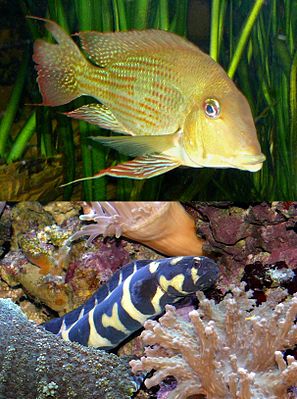Cichlid-like
| Cichlid-like | ||||||||||||
|---|---|---|---|---|---|---|---|---|---|---|---|---|

A cichlid from the genus Geophagus and Pholidichthys leucotaenia . |
||||||||||||
| Systematics | ||||||||||||
|
||||||||||||
| Scientific name | ||||||||||||
| Cichliformes | ||||||||||||
| Betancur-R. et al., 2013 |
The cichlid-like (Cichliformes) are a bony fish order from the group of Ovalentaria in the group of perch relatives (Percomorphaceae). The taxon consists of the family of the cichlids (Cichlidae), one of the most species-rich fish families with about 1700 described and numerous other undescribed species, and the family Pholidichthyidae with the only genus Pholidichthys , which has only two species in the central, tropical Indo-Pacific between the Australian north coast and the Philippines occurs.
features
Cichlids are freshwater fish that can have quite different body shapes depending on their habitat and way of life. The marine Pholidichthys species are elongated eel-like and lead an extremely hidden life in crevices and caves in the coral reef or in self-dug corridors in the seabed. The sister group relationship of the two externally quite different taxa was only recognized recently after DNA comparisons . A morphological feature shared by both groups are the individual nostrils on each side of the head (two in most other fish groups) and the eggs that sink to the bottom, which are attached to the seed opening (micropyle) with adhesive cell filaments, a feature of all ovalentaria. Another feature is the intensive brood care , which in both cases not only affects the clutch, but also includes larvae and the early juvenile fish stage. Of all marine fish, the two Pholidichthys species, with the exception of the swallowtail damselfish ( Acanthochromis polyacanthus ) and the three Altrichthys species, which are also intensively nurturing their brood but not very closely related , are the only ones for which such behavior has so far been determined.
Individual evidence
- ^ A b Joseph S. Nelson, Terry C. Grande, Mark VH Wilson: Fishes of the World. Wiley, Hoboken, New Jersey, 2016, ISBN 978-1118342336 , pages 342-345.
- ↑ a b Ricardo Betancur-R, Edward O. Wiley, Gloria Arratia, Arturo Acero, Nicolas Bailly, Masaki Miya, Guillaume Lecointre and Guillermo Ortí: Phylogenetic classification of bony fishes . BMC Evolutionary Biology, BMC series - July 2017, DOI: 10.1186 / s12862-017-0958-3
- ^ A b Peter C. Wainwright et al .: The Evolution of Pharyngognathy: A Phylogenetic and Functional Appraisal of the Pharyngeal Jaw Key Innovation in Labroid fishes and Beyond. Systematic Biology (2012), Volume 61, Issue 6, pages 1001-1027, doi : 10.1093 / sysbio / sys060
- ↑ Thomas J. Near, Alex Dornburg, Ron I. Eytan, Benjamin P. Keck, W. Leo Smith, Kristen L. Kuhn, Jon A. Moore, Samantha A. Price, Frank T. Burbrink, Matt Friedman & Peter C. Wainwright: Phylogeny and tempo of diversification in the superradiation of spiny-rayed fishes. PNAS , July 2013, doi: 10.1073 / pnas.1304661110 , PDF
- ↑ Ellen Thaler : Eel gobies and their reproduction in the aquarium. In: Coral. No. 39, 2006
- ↑ W. freshness, L. Gesset: Mysterious Aalgrundeln. In: DATZ . Vol. 59, No. 1, ISSN 1616-3222
- ↑ Ellen Thaler: Sea fish with real brood care: Swallowtail damselfish , in DATZ , 9/98